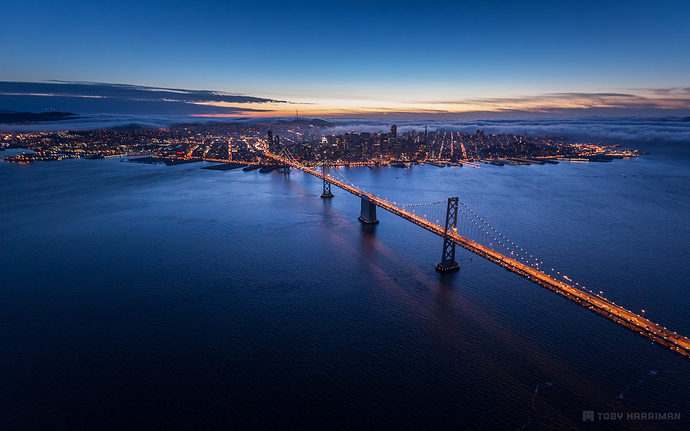Additional material to compare my SFO screenshots with
This website has very nice pictures of SFO from the air, some at sunset/night:
https://tobyharriman.com/aerial/
What is nice is the photographer is also commenting about his aperture, speed and iso which helps getting an idea how close these photos are to what you’d see IRL.
#1 I find this one quite close*:
#2 This one as well:
#3 This one is a little bit over exposed I believe but it gives an overall view of what lighting looks like in this city:
It is clear to me the very problem of night lighting is not really how far they are drawing what, rather it is what they are drawing.
When comparing just these shots it seems night lighting is a 2 factor problem mostly when seen from above:
- pole lights are illuminating the ground.
- car lights are illuminating the eye.
This means the approach I’d like to see, for lack of experimenting, is combining these:
- Use the OSM data as they are doing and as @Grinde81 has been showcasing in order to generate self-illuminated ground texture.
It is the equivalent of the “sepia mask” (which is in fact the NASA Black Marble texture) but restricted to the street and roads. Self-illumined is to be read as a rendering engine material (a texture which intensity does not depend on the sun to keep it simple. Color and width would be based on actual OSM metadata and heuristics if data is missing (near/far city centre, dense/light population area, highway/road etc…)
You can clearly see in photo #2 the “sepia mask” very close representing the highway and parking lot ground, but there is no discernable orange ground at a distance.
- Don’t use the “sepia mask” texture at a distance because there is not enough resolution.
You don’t need too much resolution even up close but at a distance, if there is not enough resolution, such texture won’t suffice to discern roads or street which are close. In effect, there could be not enough pixels to represent it all (1 pixel orange, 1 pixel black, 1 pixel orange is the strict minimum under which orange pixels blend together)
This is clearly how it looks like in photo #3 and photo #2 (see my comments above).
- Overlay all these roads and streets with actual lights emitted from actual cars.
This is what gives the most wow effect in X-Plane in my opinion and this is depicting perfectly red/yellow lights when seen in the correct direction, unlike the baked-red-dots seen in FS2020.
Photo #1 shows clearly most of the dots are cars, not poles (except on the pier). Photo #2 as well shows this clearly on the highway and in the most luminous streets. Photo #3 on the bridge up close shows the car dots are less visible than the orange ground.
- At a distance, because there is no longer the “sepia mask” texture, artificially increase either the car light dot density or the car light dot texture size in order to compensate.
Here is a gross overview of this idea which I certainly can’t illustrate nor validate right now at all, but which makes some sense to me on paper (and this could prove being a bad idea in the end).
*photos and credits from this page: https://tobyharriman.com/an-evening-above-sf/


